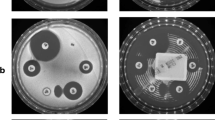Abstract
A standardized disk susceptibility test was evaluated by comparing results with minimal inhibitory concentrations obtained with agar dilution methods. The agar overlay method was used to test 152 Gram-negative bacilli against eight different antimicrobial agents. One to 3% of the isolates were resistant to an antimicrobic by the MIC method, but appeared to be susceptible by the disk method. Most very major discrepancies involved disk tests withProteus sp., a microorganism notoriously difficult to test reproducibly.Serratia sp. vs. the polymyxins andKlebsiella sp. vs. nitrofurantoin accounted for most other major discrepancies. With other microorganism-drug combinations, the disk test was a reasonably accurate technique for classifying bacteria into resistant or susceptible categories. Gentamicin disk tests were unsatisfactory, but when an intermediate zone category of 13–16 mm was applied, the false susceptible test results were reduced to 2.6%. Intermediate zone sizes were obtained with 6% of the disk tests; most of those isolates were resistant or susceptible but not intermediate in susceptibility. About 11% of the strains had intermediate MICs (5–20% with different drugs), but most of those strains were fully susceptible by the disk technique. *** DIRECT SUPPORT *** A01R4011 00007
Similar content being viewed by others
Literature Cited
Barry, A. L. 1976. The antimicrobic susceptibility test: Principles and practices. Philadelphia: Lea & Febiger.
Barry, A. L. 1977. Standardized disc diffusion methods for antimicrobic susceptibility testing of common rapid-growing bacteria, pp. 9–20. In: Bondi, A., Bartola, J. T., Prier, J. E. (eds). The clinical laboratory as an aid in chemotherapy for infectious disease. Baltimore: University Park Press.
Barry, A. L., Garcia, F., Thrupp, L. D. 1970. An improved single-disk method for testing the antibiotic susceptibility for rapidly growing pathogens. American Journal of Clinical Pathology53:149–158.
Barry, A. L., Jones, R. N., Gavan, T. L. 1978. Evaluation of the Micro-media system for quantitative antimicrobial drug susceptibility testing: A collaborative study. Antimicrobial Agents and Chemotherapy13:61–69.
Barry, A. L., Schoenknecht, F. D., Shadomy, S., Sherris, J. C., Thornsberry, C., Washington, J. A., Kramer, R. B. 1978. Interlaboratory variability of disc diffusion and agar dilution susceptibility tests with cefamandole and cephalothin. Current Microbiology1:277–280.
Barry, A. L., Thrupp, L. D. 1969. Problems in evaluating nitrofurantoin susceptibility tests with Klebsiella-Enterobacter. Antimicrobial Agents and Chemotherapy1968:415–421.
Bauer, A. W., Kirby, W. M. M., Sherris, J. C., Turck, M. 1966. Antibiotic susceptibility testing by a standardized single disk method. American Journal of Clinical Pathology45:493–496.
Brown, S. D., Washington, J. A. 1978. Evaluation of the Repliscan system for identification ofEnterobacteriaceae. Journal of Clinical Microbiology8:695–699.
Ericsson, H. M., Sherris, J. C. 1971. Antibiotic sensitivity testing: Report of an international collaborative study. Acta Pathologica et Microbiologica Scandinavica, Suppl. B217:1–90.
National Committee for Clinical Laboratory Standards. 1975. Performance standards for antimicrobial disc susceptibility tests. Villanova, Pennsylvania: National Committee for Clinical Laboratory Standards.
Thornsberry, C., Gavan, T. L., Gerlach, E. H. 1977. New developments in antimicrobial agent susceptibility testing. Cumitech 6. Washington, D.C.: American Society for Microbiology.
Turck, M., Lindemeyer, R. E., Petersdorf, R. G. 1963. Comparison of single disc and tube dilution technique in determining antibiotic sensitivities of Gram-negative pathogens. Annals of Internal Medicine58:56–64.
U. S. Department of Health, Education and Welfare. 1972. FDA rules and regulations: Antibiotic susceptibility dises. Federal Register37:20525–20529.
Washington, J. A. 1974. The agar dilution technique, pp. 54–62. In: Balows, A. (ed.), Current techniques for antibiotic susceptibility testing, Springfield, Illinois: Charles C. Thomas.
Author information
Authors and Affiliations
Rights and permissions
About this article
Cite this article
Barry, A.L., Effinger, L.J. Accuracy of the disk method for determining antimicrobic susceptibility of common Gram-negative bacilli. Current Microbiology 2, 305–309 (1979). https://doi.org/10.1007/BF02602865
Issue Date:
DOI: https://doi.org/10.1007/BF02602865




